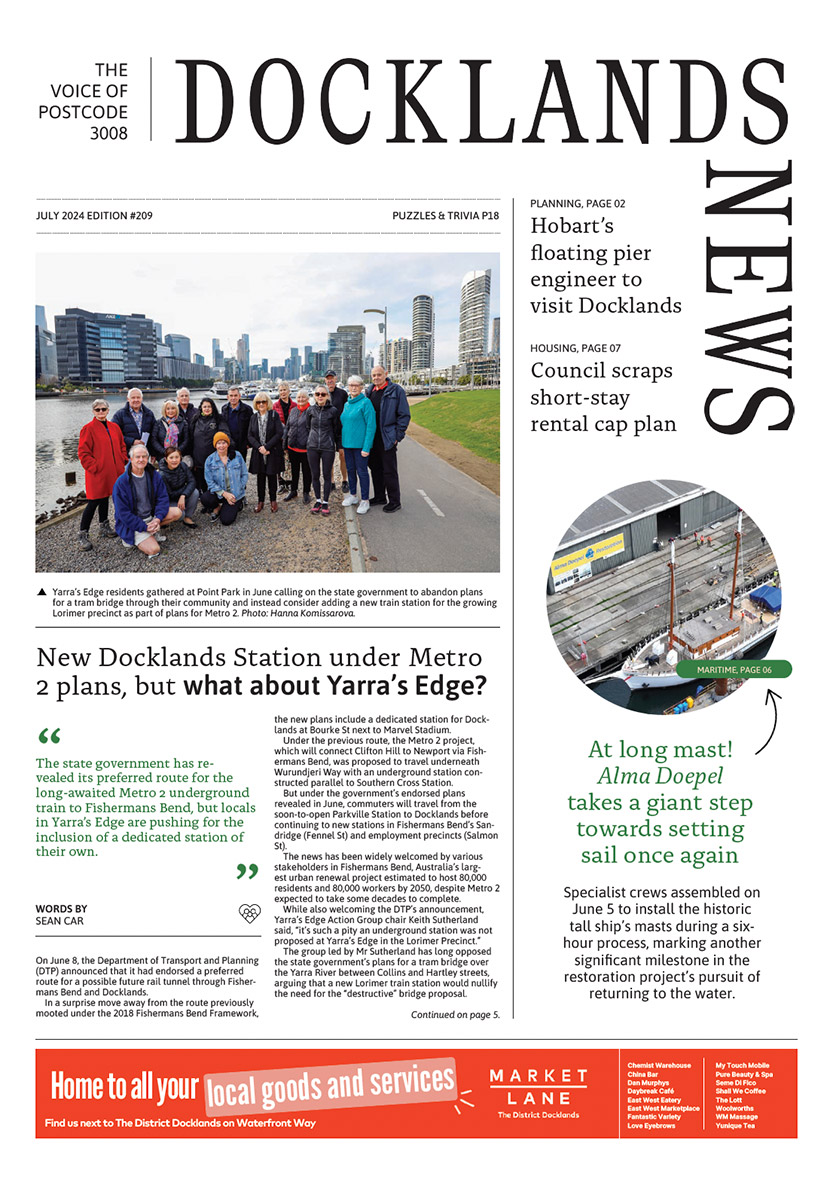Reflecting on the power of our docks
By Cr Jackie Watts
Maritime trade has been one of the enablers of Melbourne’s astounding prosperity over the past two centuries, primarily from your neighbourhood - Docklands.
So, it’s both heartening and fascinating to note that, amid all the COVID-19 economic negativity, one industry sector which has continued to flourish is maritime trade.
All levels of government recognise our ports and freight supply chains as critical elements in the economy. Docklands is playing an important role in keeping the national economy buoyant.
The Port of Melbourne functioned as a maritime trade gateway long before the Melbourne Harbour Trust (MHT) was founded, but the creation of MHT in 1877 was a major step forward. The MHT was formed to develop and manage the growth of the burgeoning Port of Melbourne, and it oversaw the construction of Victoria Dock (now Victoria Harbour) as an artificial basin between 1889 and 1892. At the time it was the second largest excavated dock in the world. If you’d like to know more you can access a truly fascinating timeline charting Docklands’ maritime trade heritage at: portofmelbourne.com/about-us/port-history/timeline/
All Docklanders will be aware of how Swanson Dock looks today but you may be less familiar with the fascinating story of how it evolved over a period of 50 years to become the epicentre of Australia’s international container trade. Former marshlands were transformed into a highly-automated “A1” cutting-edge container terminal.
Swanson Dock was named after Victor Swanson, considered a brilliant and far-sighted MHT engineer, who ultimately became its chairman. In 1965, after a study of leading international ports, Swanson foresaw in his annual Review of Operations “that ‘general cargo’ will gradually be stowed, handled, shipped and transported on land at both ends as unit cargo and containerised cargo”. Just four years later, in 1969, Swanson Dock opened. How right he was!
The Victorian Government privatised the Port of Melbourne in 2016. Four shareholder-owned companies now have the benefit of 50 year leases – QIC, Future Fund, GiP and OMERS. See portofmelbourne.com/about-us/leadership/shareholders/
Maritime trade is an intensely competitive industry in which numbers really matter – and they are very big numbers! For example, on June 26, 2020 the Port of Melbourne welcomed the largest (by maximum capacity) container vessel to ever call at the port – the CMA CGM Ural (admittedly, not the most romantic of names).
The Port of Melbourne also recently reported some impressive 2019-2020 statistical comparisons: total container volumes (full and empty) were up 7.2 per cent; full overseas container imports were up 12.8 per cent; full overseas container exports were up 7.2 per cent; and dry bulk shipments up 26.6 per cent in cement, fly ash and manufactured fertiliser (despite no June grain shipments).
Two of Australia’s major stevedoring and freight supply chain companies are engaged in this “heavy lifting” at the Port of Melbourne. The operations of DP World Australia are Australasia’s largest maritime hub for containerised, automotive and general cargo. In fact, the Melbourne business is the largest container terminal operated by this global company. See dpworldaustralia.com.au.
Patrick Terminals within the Port of Melbourne has been recognised by the Australian Bureau of Infrastructure, Transport and Regional Economics (BITRE) as the best performing terminal in the port, outperforming competitors by more than 10 berth moves per hour. patrick.com.au/locations/patrick-terminals-melbourne/
After the privatisation of Melbourne’s port operations, the state government retained authority over aspects of port management though the Victorian Port Corporation Melbourne (VPCM). VPCM provides information and advice to ship’s masters, shipping agents and owners to facilitate the safe and efficient operation of all shipping within the port waters.
The sophistication, scale and efficiency of Melbourne’s port activities reflects the dedication of thousands of Victorians involved in servicing our state’s supply chains, and we should all be proud of what has been achieved.
Mission to Seafarers – Maritime Centre proposal
There is another piece of our port infrastructure - with a long history - that we will soon be hearing much more about. The historic Mission to Seafarers building, located on the north bank of the Yarra River in the heart of the “Seafarers Precinct”, is an important landmark within Docklands. It is about to “come alive”.
Last week, councillors of the City of Melbourne unanimously endorsed the commitment of funds to support preparation of a feasibility study to establish a Maritime Centre at this iconic building, which is heritage-listed and owned by the state government. The study will be co-funded by the state government and the council. It is envisaged that this Maritime Centre will continue to provide welfare services to seafarers and maintain the marvellous Mariners Chapel. There will also be space for maritime exhibitions, educational activities and celebration. To learn more about the Mission to Seafarers see missiontoseafarers.com.au/history/
Melbourne’s “Heritage Docklands” are extensive and unrivalled anywhere else in Australia. They extend upstream and downstream from Seafarers Rest Park and the Mission to Seafarers building. Other Docklands precincts include South Wharf, Collins Wharf, Australia Wharf, Queens Wharf, Victoria Harbour, Yarra’s Edge, the Bolte West Precinct and NewQuay, and they extend beyond the river to the estuaries and creeks downriver, up to where the Yarra finally meets the bay.
The Mission to Seafarers/Maritime Centre redevelopment proposal is a vital next step in our shared quest to genuinely recognise the significance of Melbourne’s Docklands and its trade heritage •

Neighbourhood Watch and RACV launch apartment crime prevention program








 Download the Latest Edition
Download the Latest Edition